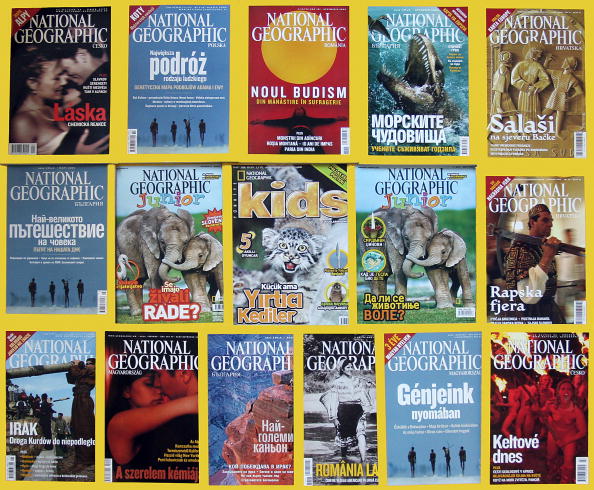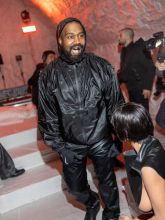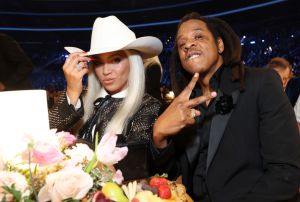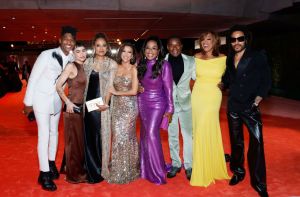Colonizers Comeuppance: National Geographic Owns Up To Their Racist Piss Poor Past POV

KAREN BLEIER/AFP/Getty Images
National Geographic Discusses Racist Past Coverage
The new issue of National Geographic is dedicated to race — which is complicated by the fact that the magazine has a racist history. So, National Geographic’s EIC Susan Goldberg decided to fess up and face the publication’s problematic past head on:
I’m the tenth editor of National Geographic since its founding in 1888. I’m the first woman and the first Jewish person—a member of two groups that also once faced discrimination here. It hurts to share the appalling stories from the magazine’s past. But when we decided to devote our April magazine to the topic of race, we thought we should examine our own history before turning our reportorial gaze to others.
It’s not exactly an apology, but Goldberg goes on to detail how the magazine enlisted University of Virginia professor John Edwin Mason to dive into their archives and uncover exactly how racist they were:
What Mason found in short was that until the 1970s National Geographic all but ignored people of color who lived in the United States, rarely acknowledging them beyond laborers or domestic workers. Meanwhile it pictured “natives” elsewhere as exotics, famously and frequently unclothed, happy hunters, noble savages—every type of cliché.
Unlike magazines such as Life, Mason said, National Geographic did little to push its readers beyond the stereotypes ingrained in white American culture.
We’ve seen those old issues of National Geographic but for a refresher, the article touches on how the magazine sent a writer and photographer to the coronation of Haile Selassie in Ethiopia in 1930, a time when the publication NEVER would have covered such an event in the United States or even allowed an African American person National Geographic membership. There’s also stuff like this:
In 1941 National Geographic used a slavery-era slur to describe California cotton workers waiting to load a ship in California: “Pickaninny, banjos, and bales are like those you might see at New Orleans.”
And this:
In a full-issue article on Australia that ran in 1916, Aboriginal Australians were called “savages” who “rank lowest in intelligence of all human beings.”
Goldberg also notes a 1962 story about South Africa completely fails to mention the massacre of 69 black South Africans by police in Sharpeville just two years before, not even bothering to consult black South Africans at all.
Goldberg concludes by looking forward:
In two years, for the first time in U.S. history, less than half the children in the nation will be white. So let’s talk about what’s working when it comes to race, and what isn’t. Let’s examine why we continue to segregate along racial lines and how we can build inclusive communities. Let’s confront today’s shameful use of racism as a political strategy and prove we are better than this…
We hope you will join us in this exploration of race, beginning this month and continuing throughout the year. Sometimes these stories, like parts of our own history, are not easy to read. But as Michele Norris writes in this issue, “It’s hard for an individual—or a country—to evolve past discomfort if the source of the anxiety is only discussed in hushed tones.”
Do you think that she said ENOUGH though? It’s one thing to say she’s not comfortable with the magazine’s past, but should she and the magazine’s publishers be MORE APOLOGETIC? What do you think?
Hit the flip for a glimpse of what the Race issue will touch on.
View this post on InstagramA post shared by National Geographic (@natgeo) on
View this post on InstagramA post shared by National Geographic (@natgeo) on
Continue Slideshow
-

Frames Per Second Podcast: Zendaya, Timothée Chalamet & More — Who’s The Future of Hollywood?
-

'Palm Royale' Exclusive: Amber Chardae Robinson On Playing Black Feminist In Series Set In 1969, 'Not Much Has Changed For Women'
-

Who Looked More Bangin'? The Best Dressed Looks From The 2024 NAACP Image Awards Red Carpet
-

Megan Thee Stallion Presents At Crunchyroll Anime Awards 2024, Stuns In Skintight Leather 'JoJo's Bizarre Adventure' Look
-

Checks Over Stripes? Kanye West Spotted In Nike At Milan Fashion Week
-

Texas Hold 'Em: 6 Times Beyoncé Reminded Us She's A Country Queen
-

Bad & Boujee: Our Hollywood Faves Dripped Decadently For The Academy Museum Gala
-

Balenci Bardi: Cardi B Makes Her Debut On The Catwalk For Balenciaga Fall '24 Show
Comments
Bossip Comment Policy
Please read our Comment Policy before commenting.